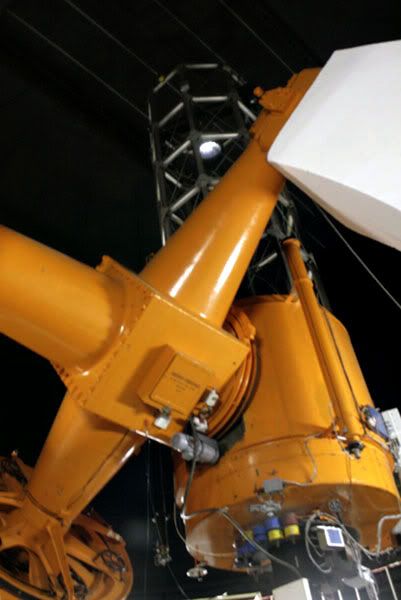 Ladies and gentlemen, this is the Radcliffe Telescope, and it's what I've been eagerly awaiting the use of for quite some time now. Unfortunately, while I'd love to be recording some spectra of the various stars on our target list right now, the weather is refusing to cooperate. With the mountaintop covered in fog, observing is currently off the menu. Sadly. So while I'm waiting for things to clear up, I might as well write a little about the 'scope...
Ladies and gentlemen, this is the Radcliffe Telescope, and it's what I've been eagerly awaiting the use of for quite some time now. Unfortunately, while I'd love to be recording some spectra of the various stars on our target list right now, the weather is refusing to cooperate. With the mountaintop covered in fog, observing is currently off the menu. Sadly. So while I'm waiting for things to clear up, I might as well write a little about the 'scope...Radcliffe is a lovely blend of early 20th century engineering and late 20th century electronics. Five metric tonnes worth of wrought iron telescope, equatorially mounted with another five metric tonnes worth of counterweight. With a 1.9 metre mirror, Radcliffe is essentially an oversized Newtonian telescope, not unlike the one I've had since I was a little kid. It's simply been scaled up. While it works as a cassegrain now, it even still has a Newtonian mounting on it. As you may be starting to guess, Radcliffe is an old telescope.
It wasn't even originally at this site. Named after an English physician, John Radcliffe, it was originally the telescope of the Radcliffe Observatory in Pretoria where it was operated between 1948 and 1972. In 1972, it was moved to its current site at the South African Astronomical Observatory here in Sutherland. Until the mirrors were installed in SALT in 2004, Radcliffe remained the largest telescope in Africa. Indeed, for quite a few years after its construction it was actually the largest telescope in the southern hemisphere, and joint fourth largest telescope in the world. Those days, however, are past and 2 metre class telescopes like Radcliffe are now considered "small telescopes" by professional astronomers. Compared to the shiny new 10 metre class telescopes now dotted around the world, Radcliffe is quite a downbeat piece of equipment with its fully manual operation and its old fashioned mechanisms. And frankly, therein lies its charm.
The most beautiful thing about using an old school telescope like this one is how hands on everything is. A series of buttons on a metal panel move the telescope, the mirror cover has to be opened using a metal crank with a wooden handle, and the sensors need to be cooled by manually refilling the liquid nitrogen tank periodically. It even has a finderscope attached to it, though this hasn't been used for some time. The finder alone is still significantly bigger than many amateur telescopes, mind you. The reason this gorgeous piece of engineering is so hands on is, simply, because it's old. Newer telescopes don't allow you quite so much freedom. I've been told that some telescopes don't really allow you to do anything yourself, being more a matter of clicking the odd button on occasion, or simply telling a telescope operator what to do. Purely for the thrill of being able to manually operate the telescope, it's been a lot of fun working with it so far, as I have no doubt it will continue to be. Provided the weather stops thwarting us!

No comments:
Post a Comment